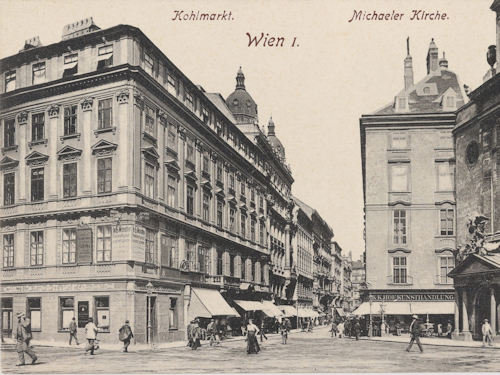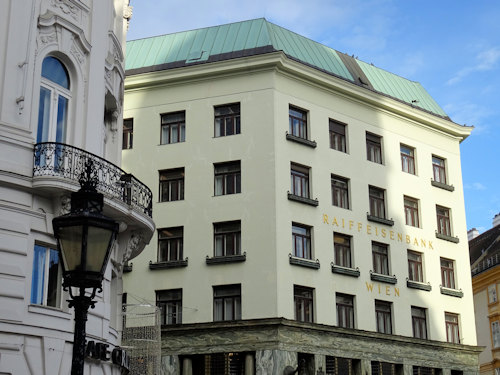
A fairly unobtrusive building in Vienna’s centre once led to much outraged clutching of breasts, pearls, and handkerchiefs among the ruling Imperial family. The Loos House even received its own nickname: the house without eyebrows.
- Built in 1912 to plans by Adolf Loos
- Marks the architectural transition to Viennese Modernism
- Allegedly hated by many traditionalists, including Emperor Franz Joseph (who lived opposite)
- Film location in Vienna Blood
- See also:
Loos House history

(The Loos house is on the left)
When tailors Goldman und Salatsch got Adolf Loos to design their new premises in the early 1900s, let’s hope they believed that any publicity was good publicity.
As a pioneer of modern architecture, Loos chose to give the new building a more functional, plainer look than was common in a Vienna dominated by historicism and the aesthetics of the local brand of Art Nouveau (Jugendstil).
The house was characterised by the stark difference between the business floor and the upper floors – the former marble-clad with columns, the latter remaining simple and largely undecorated.
Here’s how the location looked before Loos got involved (house on the left of the picture):

(1908 Postcard with a view down Kohlmarkt; Paul Ledermann (Producer); Wien Museum Inv.-Nr. 105275/90; excerpt reproduced with permission under the terms of the CC0 licence)
The change in style might have passed largely unnoticed, were the building not on Michaelerplatz square. The location is opposite one of the main entrances to the Habsburg’s very own Hofburg complex, where the Imperial family lived and worked.
It’s fair to say that Emperor Franz Joseph was not considered a huge fan of any kind of design that might attract the moniker “modern”. So you can imagine his reaction to the rather unostentatious approach taken by Loos.
To add particular insult to Imperial injury, the windows in the upper façade had no surrounding decoration, allegedly leading the Emperor to describe the building as the “house without eyebrows”.

(1912 postcard produced by Paul Ledermann with a view down Kohlmarkt soon after the Loos House went up; Wien Museum Inv.-Nr. 249827; excerpt reproduced with permission under the terms of the CC0 licence)
Popular myth has it that Franz Joseph’s dislike of the Loos House extended to refusing to ever use the palace entrance that led out onto the Michaelerplatz square.
The story goes that the emperor even ordered all the windows looking across to house number 3 shuttered, so that the monstrosity could never disturb the Imperial sense of wellbeing.
Whatever the truth, the design certainly caused much consternation, leading to delays in the construction process.
Today, however, the Loos house stands as a classic example of Viennese Modernism: the period of tumultuous creative change at the turn of the 19th and 20th centuries.

(Note the windows shockingly free of adornment)
And the building has another claim to fame, since it served as a location in the Deadly Communion episode of Season 3 of the Vienna Blood period detective drama series.
How to get to the Loos House
The Loos House sits in the historic centre of Vienna at the end of the pedestrianised Kohlmarkt.
Walk down Kohlmarkt and then turn right up the Graben, for example, to discover other architecture of the time (particularly Jugendstil houses and business locations).
Bus: Michaelerplatz has its own bus stop, cunningly named “Michaelerplatz”. Both the 1A and 2A bus routes go there.
Subway: Take the U3 line to Herrengasse.
Address: Michaelerplatz 3, 1010 Vienna